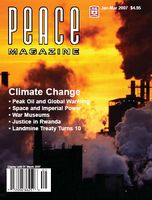
Peace Magazine Jan-Mar 2007, page 7. Some rights reserved.
Search for other articles by Debbie Grisdale here
I stood in the stairwell area known as Regeneration Hall talking with the volunteer guide about the portrayal of peace in the new Canadian War Museum. Part of her job, she explained, is to tell visitors about the intention of Regeneration Hall and point out the Peace Tower visible through the window in the east wall. She told me how, as a former teacher, she makes a special point with children to talk about the importance of working for peace in their schools and communities. As we spoke, a group of ten- and eleven-year- olds with two teachers came into the Hall, obviously on their way through. The guide turned to offer to point out the Peace Tower and explain the importance of the Hall. As the group hurried on down the stairs, one of the teachers said she was sorry but they did not have time to hear about peace as the children wanted to get downstairs to see the tanks and artillery. Too bad, I thought, another opportunity to teach about peace, lost to the allure of weapons.
It is this concern about educating for peace that led a group of Ottawa people in 2004 to begin talking about the message of the new Canadian War Museum that was being built on the banks of the Ottawa River. The museum's mandate is to portray Canadian military history and its mission is to "Remember, Preserve and Educate." Because thousands of school children visit the Museum annually, our group felt that the Museum had a responsibility to educate about peace, war prevention, disarmament, and peaceful resolution of violent conflict. We were soon joined by more than one thousand supporters from across Canada -- veterans, students, educators, politicians, journalists, and others -- in the "Make Room for Peace" Committee.
We began a dialogue with museum officials and were taken on a tour of the museum during the final stages of its construction. Officials asked what we thought children should be taught about peace during their visit to the war museum. We did not have a ready answer, but we did know that a peace curriculum should be developed by peace educators and scholars and not by military historians. We made that point emphatically and offered to help.
After the museum opened in 2005, the Make Room for Peace Committee organized a community meeting that was well attended by the public and by museum officials. Many people who came had not visited the museum because they did not want to visit a museum about war. There were moving commentaries from those who had, such as these words from a Canadian who experienced war in her native Vietnam: "The Canadian War Museum aroused compassion in me for the people who suffered due to wars, mostly for the soldiers who fought in the war and sacrificed their life or part of their body. It also gave me some knowledge of Canadian history but it fails to create an understanding of war, of how to deal with conflicts among groups and nations without using force. It also does not help me reflect on how we can live our life to promote peace and avoid war....How can we know about war if we don't learn about peace?"
The Museum depicts the human cost of war and the inhuman conditions endured by soldiers in trenches and on battlefields. As visitors we learn about the terrible tragedy of so many lives lost and are asked what particular promising young Canadians could have accomplished had they lived. There is a pervasive feeling of the inevitability of war throughout. As you enter the first permanent gallery entitled "Battleground" a sign on the wall asks "What is War?" and answers with "War is organized armed conflict. Virtually every society, past and present, makes war."
It is claimed that wars are fought to bring peace. Why wouldn't a new museum also provide a broader understanding of war -- prevention, disarmament, and the role of diplomacy, international law and treaties in ending war? And how will wars, like Iraq, that Canada has intentionally decided not to enter, be reflected?
The museum is now carrying out research for an exhibit on the Canadian peace movement, to be ready in several years' time. Members of the Committee have met with Museum staff to discuss preliminary plans and share ideas. One of our concerns is that the exhibit not be developed from a war perspective and that the peace movement not be depicted as simply a group of war protesters.
Perhaps we can never completely overcome the lure of machines and weapons, but we can create opportunities for young people to learn about creating a culture of peace, give them examples, name our heroes, and show that peace, also, takes courage.
Debbie Grisdale is the executive director of Physicians for Global Survival and is active in the Make Room for Peace committee <www.makeroomforpeace.org>.
Peace Magazine Jan-Mar 2007, page 7. Some rights reserved.
Search for other articles by Debbie Grisdale here